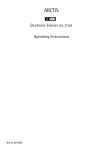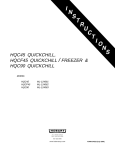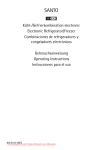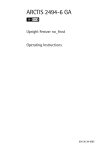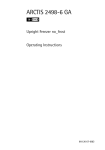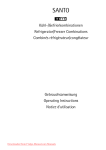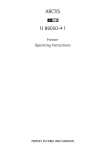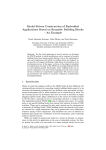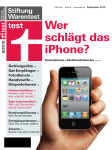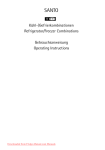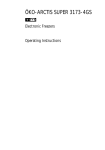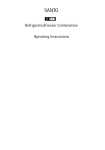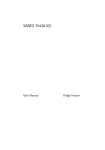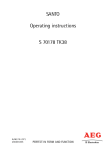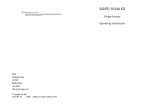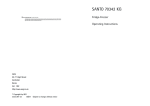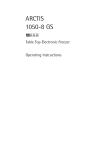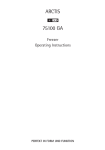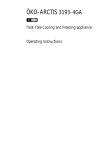Download Electrolux ARCTIS No-frost (frost free) User's Manual
Transcript
ARCTIS No-frost (frost free) Cooling and Freezing Appliance g Operating Instructions Dear customer, Before placing your new appliance into operation please read these operating instructions carefully. They contain important information for safe use, for installation and for care of the appliance. Please keep these operating instructions for future reference. Pass them on to possible new owners of the appliance. These operating instructions are for use with several technically comparable models with varying accessories. Please observe the notes which apply to your model. Notes which are important for your safety or for the proper functioning of the appliance are stressed with a warning triangle and/ or with signal words (Warning!, Caution!, Attention!). Please observe the following carefully. 0 1. This symbol and numbered instructions guide you step by step in the operation of the appliance. 2. ..... 1 3 Supplementary information regarding operation and practical applications of the appliance appear after this symbol. 2 Tips and notes concerning economical and environmentally sound use of the appliance are marked with the cloverleaf. Explanations of the technical terminology used in the operating instructions can be found at the end in the section "Technical Terminology". The operating instructions contain instructions for the correction of possible malfunctions by the user in the section "What to do if ...". If these instructions should not be sufficient, our customer service department is always available to you. Printed on paper manufactured with environmentally sound processes. he who thinks ecologically acts accordingly ... 2 Contents Safety Instructions . . . . . . . . . . . . . . . . . . . . . . . . . . . . . . . . . . . . . . . . . . . . 5 Disposal . . . . . . . . . . . . . . . . . . . . . . . . . . . . . . . . . . . . . . . . . . . . . . . . . . . . . . 7 Appliance Transport . . . . . . . . . . . . . . . . . . . . . . . . . . . . . . . . . . . . . . . . . . . 8 Remove transport safeguard . . . . . . . . . . . . . . . . . . . . . . . . . . . . . . . . . . . . 8 Installation . . . . . . . . . . . . . . . . . . . . . . . . . . . . . . . . . . . . . . . . . . . . . . . . . . . 9 Installation Location . . . . . . . . . . . . . . . . . . . . . . . . . . . . . . . . . . . . . . . . . . . . 9 The appliance needs ventilation . . . . . . . . . . . . . . . . . . . . . . . . . . . . . . . . . . . 10 Appliance Alignment . . . . . . . . . . . . . . . . . . . . . . . . . . . . . . . . . . . . . . . . . . . . 10 Electrical Connection . . . . . . . . . . . . . . . . . . . . . . . . . . . . . . . . . . . . . . . . . . . 11 Reversing the Door . . . . . . . . . . . . . . . . . . . . . . . . . . . . . . . . . . . . . . . . . . . . 13 Door Alignment . . . . . . . . . . . . . . . . . . . . . . . . . . . . . . . . . . . . . . . . . . . . . . . 15 The most important characteristic of your appliance . . . . . . . . . . . . . . 16 Appliance Description . . . . . . . . . . . . . . . . . . . . . . . . . . . . . . . . . . . . . . . . . . View of Appliance . . . . . . . . . . . . . . . . . . . . . . . . . . . . . . . . . . . . . . . . . . . . . . Freezer tray . . . . . . . . . . . . . . . . . . . . . . . . . . . . . . . . . . . . . . . . . . . . . . . . . . . . Quick door-opener . . . . . . . . . . . . . . . . . . . . . . . . . . . . . . . . . . . . . . . . . . . . . Interior Illumination . . . . . . . . . . . . . . . . . . . . . . . . . . . . . . . . . . . . . . . . . . . . Control Panel . . . . . . . . . . . . . . . . . . . . . . . . . . . . . . . . . . . . . . . . . . . . . . . . . . ON/OFF button . . . . . . . . . . . . . . . . . . . . . . . . . . . . . . . . . . . . . . . . . . . . . . Buttons for Adjusting the Temperature . . . . . . . . . . . . . . . . . . . . . . . . . . Temperature Display . . . . . . . . . . . . . . . . . . . . . . . . . . . . . . . . . . . . . . . . . FROSTMATIC button . . . . . . . . . . . . . . . . . . . . . . . . . . . . . . . . . . . . . . . . . . WARNING OFF button . . . . . . . . . . . . . . . . . . . . . . . . . . . . . . . . . . . . . . . . 17 17 18 18 18 19 19 20 20 21 21 Prior to initial start-up . . . . . . . . . . . . . . . . . . . . . . . . . . . . . . . . . . . . . . . . . 21 Initial Start-Up . . . . . . . . . . . . . . . . . . . . . . . . . . . . . . . . . . . . . . . . . . . . . . . . 22 Select "Freezing" or "Cooling" . . . . . . . . . . . . . . . . . . . . . . . . . . . . . . . . . . 22 Temperature Adjustment . . . . . . . . . . . . . . . . . . . . . . . . . . . . . . . . . . . . . . . 23 Switch on COOLMATIC . . . . . . . . . . . . . . . . . . . . . . . . . . . . . . . . . . . . . . . . . 24 Switch on FROSTMATIC . . . . . . . . . . . . . . . . . . . . . . . . . . . . . . . . . . . . . . . . 24 Switching the Appliance Off . . . . . . . . . . . . . . . . . . . . . . . . . . . . . . . . . . . . 25 3 Contents Control and Information Systems . . . . . . . . . . . . . . . . . . . . . . . . . . . . . . . . Temperature and Thawing/Defrosting Warning . . . . . . . . . . . . . . . . . . . . . . "Open Door"-Warning . . . . . . . . . . . . . . . . . . . . . . . . . . . . . . . . . . . . . . . . . . . Function Errors . . . . . . . . . . . . . . . . . . . . . . . . . . . . . . . . . . . . . . . . . . . . . . . . . 26 26 27 27 Freezing . . . . . . . . . . . . . . . . . . . . . . . . . . . . . . . . . . . . . . . . . . . . . . . . . . . . . . 28 Frozen Storage . . . . . . . . . . . . . . . . . . . . . . . . . . . . . . . . . . . . . . . . . . . . . . . . 29 Preparation of Ice Cubes . . . . . . . . . . . . . . . . . . . . . . . . . . . . . . . . . . . . . . . 29 Storage Goods Symbols/Freezing Calendar . . . . . . . . . . . . . . . . . . . . . . . . 30 Cooling . . . . . . . . . . . . . . . . . . . . . . . . . . . . . . . . . . . . . . . . . . . . . . . . . . . . . . . "Long Fresh" Cooling . . . . . . . . . . . . . . . . . . . . . . . . . . . . . . . . . . . . . . . . . . . . "Standard" Cooling . . . . . . . . . . . . . . . . . . . . . . . . . . . . . . . . . . . . . . . . . . . . . Cooling drinks . . . . . . . . . . . . . . . . . . . . . . . . . . . . . . . . . . . . . . . . . . . . . . . . . 30 30 31 31 Cleaning and Maintenance . . . . . . . . . . . . . . . . . . . . . . . . . . . . . . . . . . . . . 32 Energy Saving Tips . . . . . . . . . . . . . . . . . . . . . . . . . . . . . . . . . . . . . . . . . . . . . 33 What to do if ... . . . . . . . . . . . . . . . . . . . . . . . . . . . . . . . . . . . . . . . . . . . . . . . 34 Correcting Malfunctions . . . . . . . . . . . . . . . . . . . . . . . . . . . . . . . . . . . . . . . . . 34 Replacing the light bulb . . . . . . . . . . . . . . . . . . . . . . . . . . . . . . . . . . . . . . . . . 37 Noises during Operation . . . . . . . . . . . . . . . . . . . . . . . . . . . . . . . . . . . . . . . . 37 Regulations, Standards, Guidelines . . . . . . . . . . . . . . . . . . . . . . . . . . . . . . 38 Special Accessory . . . . . . . . . . . . . . . . . . . . . . . . . . . . . . . . . . . . . . . . . . . . . . 38 Technical Terminology . . . . . . . . . . . . . . . . . . . . . . . . . . . . . . . . . . . . . . . . . 38 Customer Service . . . . . . . . . . . . . . . . . . . . . . . . . . . . . . . . . . . . . . . . . . . . . . 39 4 1 Safety Instructions The safety of our appliances is in accordance with recognised technological standards and appliance safety legislation. We nevertheless feel that it is important to acquaint you with the following safety guidelines: Use for Intended Purpose • The appliance is intended for use at home. Depending on the preset operation mode, this appliance becomes suitable for freezing, for frozen storage of foods, for ice preparation or for cooling of foods. The manufacturer assumes no liability for damages occurring through improper operation or use of the appliance for unintended purposes. • Alterations or changes to the appliance are not permitted for reasons of safety. • Do not use this appliance in a commercial environment or for purposes other than freezing, or frozen storage of foods or for cooling of foods. Prior to initial start-up • Check the appliance for transport damage. Do not under any circumstances connect a damaged appliance! Please contact your supplier in the event of damage. Refrigerant The refrigerant isobutane (R600a) is contained within the refrigerant circuit of the appliance, a natural gas with a high level of environmental compatibility, which is nevertheless flammable. • Warning - During transportation and installation of the appliance, be certain that none of the components of the refrigerant circuit become damaged. • If the refrigerant circuit should become damaged: – avoid open flames and sources of ignition; – thoroughly ventilate the room in which the appliance is situated. Safety for Children • Packaging materials (e.g. films, styrofoam) can be dangerous for children. Danger of suffocation! Keep packaging materials away from children! • Before disposing of old appliances make them inoperable. Remove plug from mains, sever the power cable, remove or destroy any snap or latch closures. This eliminates the danger that playing children lock 5 Safety Instructions themselves into the appliance (danger of suffocation!) or place themselves into other life-endangering situations. • Children often do not recognise the dangers involved with household appliances. Please provide for the necessary supervision and do not allow children to play with the appliance! Daily Operation • Containers with flammable gases or fluids can develop leaks through contact with the cold. Danger of explosion! Do not store containers with flammable substances, such as aerosol cans, refill cartridges for cigarette lighters etc. in the appliance. • Bottles and cans may not be placed in the freezer compartment. They can burst when the contents freeze - or even explode if the contents contain carbonic acid! Never place sodas, juices, beer, wine, champagne etc. into the freezer compartment. Exception: Spirits with high alcohol content may be stored in the freezer compartment. • Do not place ice cream or ice cubes directly from the freezer compartment into the mouth. Very cold ice can freeze to the lips or tongue and cause injury. • Never touch frozen goods with wet hands. Hands can freeze to the goods. • Warning - Do not operate any electrical appliances in the appliance (e.g. electric ice cream makers, mixers etc.). • Warning - Do not cover or obstruct the ventilation openings as this will impair the operation of the appliance. • Warning - Do not use any mechanical devices or other artificial means to speed up defrosting unless they are recommended by the manufacturer. • Before cleaning the appliance switch off and remove the plug from the mains, or switch off or turn out the circuit breaker or fuse. • Placing frozen goods on the top of the appliance can lead to the accumulation of condensation on the top panel through contact with the cold. Electronic components are housed within this top panel. If water should drip onto these components, the appliance could be damaged by a short circuit. For this reason do not place frozen goods on top of the appliance. • When unplugging always pull the plug from the mains socket, do not pull on the cable. 6 In case of malfunction • If a malfunction should occur at the appliance, refer first to the section "What to do if ..." in these operating instruction. If the instructions in this section are not sufficient, do not undertake any further work on your own. • Refrigerators or feezers may only be repaired by trained personnel. Repairs carried out by untrained personnel can lead to substantial danger. Please contact your dealer or our customer service department for repairs. Disposal Appliance Packaging Information Dispose of the packaging material of your appliance correctly. All the packaging materials used are harmless to the environment and can be recycled. About the materials: The plastics can be recycled and are identified as follows: >PE< for polyethylene, e.g. the outer covering and the bags in the interior. >PS< for polystyrene foam, e.g. the pads, which are all free of chlorofluorocarbon. The carton parts are made from recycled paper and should be disposed of at a waste-paper recycling collection location. Disposal of old Appliances For environmental reasons, refrigeration appliances must be disposed of properly. This applies to your old appliance, and - at the end of its service life - for your new appliance as well. 1 Warning! Before disposing of old appliances make them inoperable. Remove plug from mains, sever the power cable, remove or destroy any snap or latch closures. This eliminates the danger that playing children lock themselves into the appliance (danger of suffocation!) or place themselves into other life-endangering situations. Disposal: • The appliance may not be disposed of with domestic waste or bulky refuse. • The refrigerant circuit, especially the condenser at the back of the appliance, must not be damaged. • Information concerning collection schedules or locations can be obtained from the local disposal authorities or town hall. 7 Appliance Transport Two people are required to transport the appliance. There are two recessed handles at the front of the base and at the back of the appliance at the top for improved gripping. 0 1. Pull the plinth cover forwards to remove (see „Reversing the door“, Item 1). 2. Grip the appliance with the recessed handles positioned as in the drawing, and transport the appliance. 3. In order to push the appliance into its final position, press carefully at the top of the door and tip the appliance back slightly. The weight is thus transferred to the back casters and the appliance can be easily pushed. Remove transport safeguard The appliance as well as interior accessory parts are protected for transport. 0 1. Remove tape from left and right of the outside of the door. 3 Tape remnants can be removed with white spirit. Wipe off white spirit. 2. Remove all tape and pads from the interior of the appliance. 3. Peal off the protective film from the control panel, if existing. 4. Remove door seal safeguards from door seal on the inside of the door. 8 Installation Installation Location The appliance should be installed in a well ventilated, dry room. Energy use and efficient performance of the appliance is affected by the ambient temperature. The appliance should therefore – not be exposed to direct sunlight; – not be installed next to radiators, cookers or other sources of heat; – only be installed at a location whose ambient temperature corresponds to the climate classification, for which the appliance is designed. The climate classification can be found on the rating plate, which is located at the left on the inside of the appliance. The subsequent table shows which ambient temperature is assigned to which climate class if the operation mode "Freezing" is selected: Climate classification for an ambient temperature of SN +10 to +32 °C N +16 to +32 °C ST +18 to +38 °C T +18 to +43 °C Attention! If the operation mode "Cooling" is selected, the ambient temperature at the installation place must be at least 2 °C higher than the preset DESIRED temperature. 9 Installation The appliance needs ventilation Air is fed under the door through the vent slots in the base and is vented upwards along the back wall. To ensure proper air circulation never cover or alter the vent openings. Attention! If the appliance is installed under, for example, a hanging cabinet, a clearance of at least 10 cm between the top of the appliance and the cabinet above it must be maintained. 0 1. Break both wall spacing elements from the plinth and insert them into the sockets at the back side of the appliance, according to the figure, so that the required wall gap for the necessary ventilation at the back of the appliance is provided for. Appliance Alignment 0 1. The appliance must have a solid, level footing. Please compensate for unevenness in the floor by turning the two adjustable feet at the front in or out. 10 Installation Electrical Connection A properly installed socket outlet with earthing contact is required for electrical connection. Electrical fuse protection must be of at least 10 ampere. If the outlet socket is no longer accessible after installation of the appliance, appropriate measures must be taken during electrical installation to assure that the appliance can be disconnected from the mains (e.g. fuse, circuit breaker, non-operate current safety-switch or the like, with a contact opening of at least 3 mm). 0 1. Before initial start-up, refer to the appliance rating plate to ascertain if supply voltage and current values correspond with those of the mains at the installation location. e.g.: AC 220 ... 240 V 50 Hz or 220 ... 240 V~ 50 Hz (i.e. 220 to 240 volts alternating current, 50 Hertz) The rating plate is inside the appliance at the left. Warning: To avoid potential danger, if the mains connection lead of this appliance is damaged, it must be replaced by our customer service representative or a person with similar qualifications. Warning: Under no circumstances should the appliance be connected to electronic “power saving plugs” or to a.c.-d.c. converters which convert direct current to 230 V alternating current (e.g., solar installations, ship networks) 11 Installation Electrical Connection (valid for United Kingdom only) Any electrical work required to install this appliance should be carried out by a qualified electrician or competent person. 1 WARNING – THIS APPLIANCE MUST BE EARTHED The manufacturer declines any liability should these safety measures not be observed. Before switching on, make sure the electricity supply voltage is the same as that indicated on the appliance rating plate. The rating plate is inside, on the left. The appliance is supplied with a 13 amp plug fitted. In the event of having to change the fuse in the plug supplied, a 13 amp ASTA approved (BS 1362) fuse must be used. Important The wires in the mains lead are coloured in accordance with the following code: Green & Yellow Green and Yellow Earth Blue Neutral Brown Live Blue Brown Cord Clamp As the colours of the wires in the mains lead of this appliance may not correspond with the coloured markings indentifying the terminals in your plug, proceed as follows: 1. The wire coloured green and yellow must be connected to the terminal marked with the letter „E“ or by the earth symbol or coloured green and yellow. 2. The wire coloured blue must be connected to the terminal „N“ or coloured black. 3. The wire coloured brown must be connected to the terminal marked „L“ or coloured red. 4. Upon completion there must be no cut, or stray strands of wire present and the cord clamp must be secure over the outer sheath. 1 12 Warning! A cut-off plug inserted into a 13 amp socket is a serious safety (shock) hazard. Ensure that the cut-off plug is disposed of safely. Reversing the Door The side at which the door opens can be changed from the right side (factory adjustment) to the left side, if the installation site requires. 1 Warning! When changing the side at which the door opens, the appliance must not be connected to the mains. Remove plug from the mains beforehand. Parts supplied are for door closer (B2 and C2) with the door hinged on the left. Please retain removed parts for possible later changes to the side on which the door is hung. 0 1. Pull base cover forward to remove. 2. With door closed screw pivot pin (A) out of the lower door pivot. 3. Lift the door carefully, remove to the front and place on one side. 4. Remove slider for the door closer (B1) from the right lower part of the door (if necessary using a sharp screwdriver). Separate the corresponding supplied slider (B2) from the connecting piece and insert it at the bottom left side of the door. 13 Reversing the Door 5. Remove slider for the door closer (C1) from the right lower door pivot, if necessary using a sharp screwdriver (1). Transfer covers on door pivots from left to right (2, 3), separate supplied slider for the door closer (C2) from the connecting piece, and place it on the lower left door pivot (4). 6. Reposition upper pivot pin to the left side. 7. Pry out cap at upper left of the door with a small screwdriver and reposition it to the right side. 8. Carefully set door into upper pivot pin and close. 9. Turn pivot pin (A) into lower door pivot at the left. 14 10. Reposition door handle and hole plug-pins as shown in the diagram. 11. Replace base cover. Door Alignment If necessary, the appliance door can be aligned. 0 1. First remove the door (see section: "Reversing the Door"). 2. Remove slider for door closer B1 (B2 for door hinged on the left). 3. Using a small screw-driver, lift out the eccentric bearing bushes as required, above and below the door, rotate and then press in according to the figures. The diagram only shows a right opening door. For left opening doors please proceed accordingly at the left of the door at top and/or bottom. 4. Reposition slider for door closer B1 (B2 for door hinged on the left). 5. Replace the door (see section: "Reversing the Door") 15 The most important characteristic of your appliance • The appliance can be used as a freezing unit or as a refrigerator depending on requirement. For this purpose, the operation mode "Freezing" or the operation mode "Cooling" can be selected on the appliance. – In the operation mode "Freezing", the appliance is usable for freezing and deep-temperature storage with temperatures from -15 °C up to -24 °C. – In the operation mode "Cooling", this appliance can be operated as a "long fresh" cooling unit with temperatures of 0 °C to +2 °C, whereby a dry cabinet interior climate is attained through the nofrost (frost-free) technology. The appliance can also be used in the adjustable temperature range of up to +16 °C as a chilled cupboard for food and drink. Naturally, it is also usable as a "normal" refrigerator for the temperature range of +2 °C to +5 °C. • COOLMATIC/FROSTMATIC can be selected depending on purpose and need. – The COOLMATIC function is suitable for fast cooling larger quantities when in the refrigerator mode, e.g. for drinks or salads during a party. Thereby, a DESIRED temperature of +2 °C is automatically preset. After 6 hours have expired, the COOLMATIC function is terminated automatically. – The FROSTMATIC function caters for quick freezing of fresh foodstuffs and protects at the same time the foodstuff already stored against undesired temperature increase when in the freezer mode. The electronics of the appliance recognises automatically, when the quick freezing mode can be completed, and automatically switches off the FROSTMATIC function.(Depending upon the quantity to be frozen after 30 up to maximum 51 hours). • The no-frost (frost free) system enables both the freezing of fresh foodstuff as well as the storage of readily frozen or cooled foodstuff by cold air. An evaporator cools the air in the interior space of the appliance, which is circulated and uniformly distributed by a ventilator. This uniformly circulating air-flow creates for a dry climate, low temperature fluctuations and low temperature differences in the entire appliance interior. The moisture in the air condenses as frost on the evaporator. The evaporator thaws/defrosts automatically, as soon as this is necessary. The melted water is 16 drained off outside to the compressor and evaporates through the heat generated by the latter. Thus, the interior of the appliance and the stored cooled or frozen foodstuffs always remain fresh and icefree. Manual thawing/defrosting is not necessary. Appliance Description View of Appliance (various models) ➀ ➁ ➂ ➃ ã å Freezer tray Drawers Evaporator Interior Illumination Control Panel Rating plate 17 Appliance Description Freezer tray A freezing tray is inserted in the middle of the appliance’s interior. 3 Berries, for example, can be pre-frozen on the freezer tray. Advantage: The berries are not squashed and maintain their natural form. The frozen berries can then be stored in compartments or drawers packaged in individual portions. The freezing tray also serves for accommodating small frozen foodstuffs (e.g. herbal produce), furthermore you can accommodate ice cube shells. Quick door-opener The quick door-opener enables easy opening through its integrated opening mechanism. Please observe that both tappets (A) always interlock in the fold of door seal, according to the figure. Interior Illumination The illumination switches on automatically when the appliance door is opened. By closing the appliance door it is automatically switched off. 3 18 If the appliance door remains open for more than 5 minutes, the interior illumination starts to blink and then switches off automatically in order to save energy. If directly after opening the door the interior illumination is not glowing although the appliance is in operation (recognisable through the green mains control indicator), the lamp is defective. Replacement procedure is described in the "Replacing the light bulb" chapter. Appliance Description Control Panel 1 2 3 4 5 6 7 8 9 Stand-by display (green) (mains confirmation) ON/OFF button Button for adjusting the temperature (for warmer temperatures) Temperature Display (negative temperatures are indicated by an illuminated “-” sign) Button for adjusting the temperature (for colder temperatures) Display when COOLMATIC or FROSTMATIC function is switched on (yellow) FROSTMATIC/COOLMATIC button Warning Display (red) WARNING OFF button (See the chapter on "Control and Information Systems") ON/OFF button • Switching on: When first switched on (delivery state) your appliance starts in the operation mode "Freezing". By renewed switching on, your appliance restarts in the operation mode, which was set prior to switching off. • Switch off: To switch off, hold the button pressed for approx. 2 seconds (see section “Switching the Appliance Off”). • To switch between “Freezing” and “Cooling” modes: hold down the ON/OFF button and the WARNING OFF button simultaneously for 5 seconds (see section Selecting “Freezing” or “Cooling” ). 19 Appliance Description Buttons for Adjusting the Temperature The temperature is adjusted using the „+“ (WARMER) and „-“ (COLDER) buttons. These buttons are connected to the temperature display. • The temperature display is switched over from the display of the ACTUAL temperature (Temperature display is illuminated) to the display of the DESIRED temperature (Temperature display flashes) by pressing one of the two buttons, „+“ (WARMER) or „-“ (COLDER). • Each time one of the two buttons is pressed again the DESIRED temperature is adjusted by 1 °C. • If neither button is pressed, the temperature display automatically switches back after a short period (approx. 5 sec.) to the display of the ACTUAL temperature. The ACTUAL temperature in the appliance is now adjusted to match the preset DESIRED temperature. DESIRED temperature means: The temperature that is required in the appliance, this can be adjusted to the temperatures shown in the display. The DESIRED temperature is indicated by flashing numbers. ACTUAL temperature means: The temperature display indicates the temperature that is currently present in the appliance. The ACTUAL temperature is indicated with illuminated numbers. 3 If the FROSTMATIC or COOLMATIC functions are switched on it is not possible to change the temperature setting. Temperature Display The temperature display shows several types of information. • In normal operation the current freezer compartment temperature is displayed (ACTUAL temperature). • During temperature adjustment, a blinking display of the temperature selected at the moment occurs (DESIRED temperature). • In the COOLMATIC function "IC" for intensive cooling appears in the display . The current freezer temperature appears in the display while FROSTMATIC is functioning. If one of the temperature setting buttons is 20 pressed, “SF” (Super Frost) will appear in the display for 5 seconds. The display will then revert to showing the current freezer temperature. • In the event that frozen food has been partially or totally defrosted, perhaps as the result of a lengthy power failure, if the WARNING OFF button is activated the temperature display will show the warmest temperature the frozen food has reached on restoration of the power supply. • If there is a fault in the appliance a square or error code (F7 or F8) will appear in the temperature display. FROSTMATIC button When FROSTMATIC- or COOLMATIC function is switched on, the yellow control display near the button illuminates. • With the FROSTMATIC button, the "FROSTMATIC" function can be switched on if the appliance is in the "Freezing" operation mode, or the "COOLMATIC" function, when the appliance is in the "Cooling" operation mode. Information: When in FROSTMATIC mode the appliance is operating at maximum refrigerating capacity. The noises produced by the refrigerating unit may be temporarily louder. WARNING OFF button With the WARNING OFF button, the acoustic warning signal can be switched off, e.g. the "Open Door" warning when sorting in or out, the commodities to be cooled or frozen. When there is a partial/total thaw warning, if the WARNING OFF button is activated the temperature display will show the warmest temperature the frozen food has reached on restoration of the power supply. Prior to initial start-up 0 1. Please clean the interior and all accessories prior to the initial operation (see the "Cleaning and Maintenance" chapter). 2. The appliance must be correctly installed in accordance with the chapter "Installing and Connecting" before it is put into operation for the first time. Care should be especially taken that the mains voltage and frequency available correspond with the appliance’s rating plate. 21 Initial Start-Up 0 1. Insert plug into mains socket. 2. Press ON/OFF button. The green stand-by (mains confirmation) display lights up. The temperature display shows the current temperature in the appliance (ACTUAL temperature). The red warning indicator will flash to indicate that the necessary storage temperature has not yet been reached. After the appliance has been switched on, the warning tone is suppressed until such time as the DESIRED temperature is reached. If, instead of using the ON/OFF button, the appliance has been switched off by removing the plug from the mains, the warning tone will be activated when the appliance is started up again. 3 In the delivery state, your appliance is present in the operation mode "Freezing". If the appliance was once in operation, it restarts in the operation mode, which was set prior to switching off. Select "Freezing" or "Cooling" If necessary, switch over the appliance with the following steps between the operating modes "Freezing" and "Cooling": 0 1. Hold down the ON/OFF button and the WARNING OFF button simultaneously for 5 seconds. • When the setting is switched from “Freezing” to “Cooling” “FC” (Freezing -> Cooling) appears in the temperature display, an acoustic signal confirms the change and the temperature display changes to flashing figures (DESIRED temperature cooling mode 5 °C). Using the temperature setting buttons, the required temperature for the cooling mode can now be entered. • When the setting is switched from “Cooling” to “Freezing” “CF” (Cooling -> Freezing) appears in the temperature display, an acoustic signal confirms the change and the temperature display changes to flashing figures (DESIRED temperature freezing mode -18 °C). Using the temperature setting buttons, the required temperature for the freezing mode can now be entered. 3 22 The operation mode, in which your appliance is at the moment, is identifiable if the temperatures can be set above or below 0 °C. 2. Set the temperature depending upon the selected operation mode (see the chapter "Setting the Temperature"). Attention! If you are using the appliance as a freezing unit: Please wait prior to putting the foodstuff to be frozen, until the freezer interior temperature has attained -18 °C, or until the red warning display goes off. Attention! If you are using this appliance as a cooling unit, after it has been used as a freezing unit: Please wait until the temperature has reached 0 °C before putting the foodstuff to be cooled in the appliance. Temperature Adjustment 0 1. Press either the „+“ (WARMER) or „-“ (COLDER) button. The temperature display switches over and the DESIRED temperature currently set flashes on the temperature display. 2. To adjust to a warmer temperature, press the „+“ (WARMER) button. To adjust to a colder temperature, press the „-“ (COLDER) button. The changed setting is immediately displayed on the temperature display. Each time one of the two buttons is pressed again the DESIRED temperature is adjusted by 1 °C. Note: From a food safety point of view, -18 °C should be considered cold enough as a storage temperature. 3 When the buttons are not further pressed after an adjustment has been made, after a short period (approx. 5 sec.) the temperature display switches over and again displays the ACTUAL temperature in the freezer compartment. The display changes from flashing to continuous illumination. 3 The following DESIRED temperature settings are possible: • Operating mode "Freezing": from -15 °C up to -24 °C in 1 °C steps; • Operation mode "Cooling": from 0 °C up to 16 °C in 1 °C steps; Attention! If the operation mode "Cooling" is selected, the ambient temperature at the installation place must be at least 2 °C higher than the preset DESIRED temperature. Important! Please regularly check that the storage temperature is being maintained by checking the red warning light and the temperature display. 23 Switch on COOLMATIC MATIC (Only possible in operation mode "Cooling") COOLMATIC function is suitable for fast cooling larger quantities of foodstuff when in the cooling mode, e.g. drinks or salads during a party. 0 1. Press the FROSTMATIC button. The yellow control indicator near the FROSTMATIC button illuminates. 3 The COOLMATIC function now caters for intensive cooling. Thereby a DESIRED temperature of +2 °C is automatically preset. After 6 hours have lapsed, the COOLMATIC function is independently ended. The appliance returns to the originally set DESIRED temperature and the temperature display again displays the current appliance interior temperature. 2. You can manually terminate the COOLMATIC function at any time, in that you press the FROSTMATIC button again. Important! Once the COOLMATIC function has been switched on the DESIRED temperature that was set originally cannot be changed. When the COOLMATIC function is switched on “IC" for Intensive Cooling appears in the temperature display. If the set DESIRED temperature is lower than 3 °C the COOLMATIC function will have no effect. Switch on FROSTMATIC (Only possible in the operating mode "Freezing") The FROSTMATIC function caters for fast freezing of fresh foodstuffs and simultaneously protects the already stored foodstuffs against undesired temperature rise in the freezing room. 0 1. Press the FROSTMATIC button. The yellow control display near FROSTMATIC button illuminates. 3 The electronics of the appliance independently recognises when the quick freezing process can be terminated, and then switches off the FROSTMATIC function automatically (depending on the quantity to be frozen after a minimum of 30 hours to maximum 51 hours). 2. You can stop the fast freezing process manually at any time by pressing the FROSTMATIC button again. 24 Important! Once the FROSTMATIC function has been switched on the DESIRED temperature that was set originally cannot be changed. The current freezer temperature appears in the display when the FAST FREEZE function is switched on. If one of the temperature setting buttons is pressed, “SF” (Super Frost) will appear in the display for 5 seconds. The display will then revert to showing the current freezer temperature. Information: When in FROSTMATIC mode the appliance is operating at maximum refrigerating capacity. The noises produced by the refrigerating unit may be temporarily louder. Switching the Appliance Off In order to protect frozen goods, the appliance is guarded against accidental switching off (child-proof). 0 1. To switch off press and hold the ON/OFF button for about 2 seconds. A so-called "count down" is started in the temperature display, which counts backwards from "3" to "1". After "1" is reached the appliance switches off. Illumination at the temperature display goes off. Note: The appliance cannot be switched on or off if unplugged, or if there is no power being supplied to it. Following connection to the mains power supply, the appliance returns to the same operating state as before the interruption of main power. If the appliance is to be removed from service for a lengthy period: 0 1. Switch appliance off by pressing and holding the ON/OFF button for about 2 seconds (see above). 2. Remove the mains plug or switch off or turn out the circuit breaker or fuse. 3. It is essential to clean the appliance (see the "Cleaning and Maintenance" chapter). 4. Leave door open to avoid accumulation of odours. 3 When put into operation again, the appliance starts in the operation mode, in which it was set prior to switching off. 25 Control and Information Systems The control and information systems consist of a temperature display, an optical warning display and an acoustic warning device. The system warns of: – open appliance door; – excessive temperature in the freezer compartment (only in the operation mode "Freezing"); – possible partial or complete thawing of frozen goods; – functional disturbances at the appliance. 3 Without signifying any risk to the frozen food the warning tone can come on: – when larger quantities of fresh foods are stored; – if the appliance door is left open too long; Temperature and Thawing/Defrosting Warning (only in the operating mode "Freezing“) The red warning indicator flashes and a warning tone sounds as soon as the temperature in the freezer rises above -12 °C. 0 1. You can cancel the warning tone with the WARNING OFF button. The temperature display for the freezer indicates the warmest temperature the freezer has reached during the temperature alarm period. After approx. 5 seconds the temperature display reverts to the current freezer temperature. 3 26 While the current freezer temperature is warmer than -12 °C, the warmest temperature the freezer has reached during the alarm period is stored and can be called up as often as wished by pressing the WARNING OFF button. When the temperature in the freezer falls below -13 °C, the warning tone switches off automatically. The red warning indicator will continue to flash. If the WARNING OFF button is pressed now, the red warning indicator switches off. In addition, the temperature display will show for five seconds the highest temperature the frozen food has warmed to. Then the display will change to the current freezer temperature. The stored highest temperature is now erased. Information: After the appliance has been switched on, the warning tone is suppressed until such time as the DESIRED temperature is reached. Control and Information Systems Such a temperature increase is probably due to: – frequent or extended opening of the door; – storing large quantities of warm food; – high ambient temperature; – a fault in the appliance. Attention! If suspicion of partial or complete thawing exists, please check the quality of the foods to determine if they can be used. "Open Door"-Warning The red warning indicator flashes when the door is opened. If the door remains open longer than approx. 80 seconds, an extra warning tone sounds. If you need more time for sorting or rearranging frozen foodstuff, you can switch off warning tone for 80 seconds by pressing the WARNING OFF button. The red warning indicator will go out when the door is closed. Function Errors If the appliance electronics detect a technical fault that needs to be rectified by customer service, the temperature display shows a square or an error code (F7 or F8) in the lower part of the temperature display. The red warning indicator flashes. The appliance will continue to operate in emergency mode. 27 Freezing (only in the operating mode "Freezing“) Attention! • Before foods are frozen, the actual temperature in the freezer compartment must be -18 °C or colder. • Please observe indicated freezing capacity on the rating plate. The freezing capacity represents the maximum amount of fresh goods that can be frozen within 24 hours. If you freeze goods on several days, one after the other, freeze amounts equal to 2/3 to 3/4 of the capacity indicated on the rating plate. • Thawed foods which have not been processed further (cooked into meals) may not under any circumstances be frozen a second time. 0 1. For exploitation of maximum freezing capacity press the FROSTMATIC button 24 hours prior to freezing, or 4 to 6 hours for smaller quantities. Yellow display lights up. 3 The FROSTMATIC button need not be pressed for freezing of small quantities of up to 3 kg. When larger quantities of food are frozen the temperature warning may be activated even when the FROSTMATIC function has been switched on. 2. All foods must be packed air tight prior to freezing, so that they do not dry out or lose their flavour, and so that no flavour contamination of other frozen goods occurs. Caution! Do not touch frozen goods with wet hands. Hands can freeze to the goods. 3. Place packaged foods in the compartments or drawers. Unfrozen goods may not come into contact with already frozen goods, otherwise the frozen goods may start to thaw. 3 28 The appliance electronics recognise automatically when the FROSTMATIC function can be ended, and switch it off automatically. Yellow display goes out. You can also stop the FROSTMATIC function manually by pressing the FROSTMATIC button again. • To allow storage of awkward freezing foodstuff, the drawers of the appliance are individually removable. They can be stacked in the one lying below. • The following are suitable for packing foodstuffs to be frozen: – freezing bags and foils made of polyethylene; – special tins for frozen food; – aluminium foil, extra strong. • The following are suited for sealing bags and wraps: plastic clips, rubber bands or adhesive tape. • Press air out of bags and wraps before sealing, because air encourages drying of frozen goods. • Make flat packages, because these freeze more quickly. • Do not fill cans for frozen goods to the brim with liquid or paste-like goods, because liquids expand during freezing. 3 Note for inspection authorities: Batch plans for the determination of freezing performance or warm-up time can be requested directly from the manufacturer. Frozen Storage Attention! Before initial loading of the freezer compartment with previously frozen goods, the required storage temperature of -18 °C must be reached. • Load freezer only with packaged frozen goods, so that they do not dry out or lose their flavour, and so that no flavour contamination of other frozen goods can occur. • Please observe maximum storage times and expiry dates of frozen goods. 2 In so far as possible store frozen goods separately according to type in compartments and drawers. Thus, you will have a better overview, avoid opening the door for a long time and save power. 3 From a food safety point of view, -18 °C is deemed sufficient as cold storage temperature. Preparation of Ice Cubes 0 1. Fill ice cube tray (not included with all models) 3/4 full with cold water and place in the freezer tray or a drawer and allow to freeze. 2. To remove the finished ice cubes twist the ice cube tray or hold under running water for a short time. Attention! Do not, under any circumstances, free an ice tray which is frozen to the appliance with pointed or sharp edged objects. Use a spoon-handle or similar object. 29 Storage Goods Symbols/Freezing Calendar (not included with all models) • The symbols on the compartment flaps and drawers show different types of frozen goods. • The numbers indicate storage times in months for the appropriate types of frozen goods. Whether the upper or lower value of the indicated storage time is valid depends on the quality of the foods and pre-treating before freezing. The lower value applies to foods with high fat content. Cooling The appliance is suitable, depending upon the preset temperature, for • "Long Fresh" Cooling • "Standard" Cooling • Drinks cooling. 3 The drawers of the appliance can be removed individually. The removal is then especially advantageous if due to its size the foodstuff you want to cool does not fit inside a drawer. You can in this case stack the drawer below correspondingly higher. Instead of the drawers, wire shelves can also be pushed in. You can purchase the wire shelves as special accessory from your AEG product supplier. "Long Fresh" Cooling By selecting the DESIRED temperature of 0 °C up to +2 °C this appliance can be used as a "Long Fresh" cooling unit. The "Long Fresh" cooling process enables optimum storage conditions for fresh foodstuff. The foodstuff remains fresh up to three times longer in comparison to storage in normal refrigerators. 30 Cooling • Commodities suitable for "Long Fresh" cooling are: – meat and sausages – fresh poultry – fresh fish – milk, butter, curd cheese – berries, fruits and vegetables – salads, mushrooms. • Foodstuff unsuitable for "long fresh" cooling are: – coldness-sensitive fruits, e.g. bananas, papayas, passion fruits, avocados and citrus fruits; – coldness-sensitive vegetables, e.g. paprika, cucumber, zucchini, egg-plants, potatoes and tomatoes; – Fruits and vegetables, which should still ripen, e.g. pears. • Pack all foodstuffs prior to "long fresh" cooling. Thus, the aroma, the moisture and the colour is retained longer. • The following are suited for packaging: – Airtight bags and foils made of polyethylene – Closable plastic containers – aluminium foil. "Standard" Cooling By selecting the DESIRED temperature in the range of +5 °C, this appliance can be used as a normal refrigerator. • Foodstuff should always be covered or packed in the cool room, in order to prevent drying out and odour or taste transmission to other cooled foodstuffs. • The following are suited for packaging: – Airtight bags and foils made of polyethylene – Plastic container with cover – Special hoods made of plastic with rubber band – aluminium foil. Cooling drinks By selecting the DESIRED-Temperature up to +16 °C, the appliance can perfectly be used as a cooling unit for drinks. 31 Cleaning and Maintenance For hygienic reasons the appliance interior, including interior accessories, should be cleaned regularly. 1 Warning! • The appliance must not be connected to the mains during cleaning. Danger of electrical shock! Before cleaning switch the appliance off and remove the plug from the mains, or switch off or turn out the circuit breaker or fuse. • Never clean the appliance with a steam cleaner. Moisture could accumulate in electrical components, danger of electrical shock! Hot vapours can lead to the damage of plastic parts. • The appliance must be dry before it is placed back into service. • The appliance defrosts automatically. Do not use mechanical or artificial devices to accelerate the defrosting process. Attention! • Ethereal oils and organic solvents can attack plastic parts, e.g. – lemon juice or the juice from orange peals; – butyric acid; – cleansers which contain acetic acid. Do not allow such substances to come into contact with appliance parts. • Do not use any abrasive cleansers. 0 1. Press the FROSTMATIC button about 12 hours prior to cleaning, so that the frozen goods can build up a sufficient chill reserve. Caution! Do not touch frozen goods with wet hands. Hands can freeze to the goods. 2. Remove frozen goods, pack them in several layers of newspaper, cover them and store them in a cool place. 3. Switch appliance off by pressing and holding the ON/OFF button for about 2 seconds. 4. Remove the mains plug or switch off or turn out the circuit breaker or fuse. 5. Clean the appliance and the interior accessories with a cloth and lukewarm water. 6. After cleaning wipe with clean water and rub dry. 32 2 Accumulation of dust at the condenser increases energy consumption. For this reason carefully clean the condenser at the back of the appliance once a year with a soft brush or a vacuum cleaner. 7. After everything is dry place appliance back into service. 2 Energy Saving ving Tips • Do not install the appliance near cookers, radiators or other sources of warmth. High ambient temperatures cause longer, more frequent operation of the compressor. • Ensure sufficient air circulation and exhaust at the appliance base and at the back wall of the appliance. Never cover air vent openings. • Do not place warm foods into the appliance. Allow warm foods to cool first. • Only leave door open as long as necessary. • Do not set temperature any colder than necessary. • Place frozen goods into the refrigerator for thawing. Cold from frozen goods is thus used for cooling in the refrigerator. • Always keep the condenser at the back of the appliance clean. 33 What to do if ... Correcting Malfunctions Perhaps a malfunction has been caused by a minor error, which you can correct yourself with the help of the following instructions. Do not attempt any further repairs if the following instructions do not help in each specific case. 1 Warning! Refrigerators/freezers may only be repaired by trained personnel. Repairs carried out by untrained personnel can lead to substantial danger for the user. Please contact your dealer or our customer service department for repairs. Malfunction Remedy Appliance is not switched on. Switch appliance on. Mains plug is not inserted or is loose. Insert mains plug. Fuse has blown or is defective. Check fuse, replace if necessary. Mains socket is defective. Mains malfunctions are to be corrected by an electrician. Red warning display flashes, temperature display shows temperature below -13 °C, door is closed. Partial/Complete Thaw Warning. Frozen goods have been warmed to such an extent that they have been partially or completely thawed. Please refer to the section "Control and Information Systems". Red warning display flashes, warning tone sounds, temperature display shows temperature above -13 °C, door is closed. Partial/Complete Thaw Warning. Frozen goods have been warmed to such an extent that they have been partially or completely thawed. Please refer to the section "Control and Information Systems". Appliance does not function, green stand-by (mains confirmation) and temperature displays are not lit. 34 Possible cause What to do if ... Malfunction Red warning indicator is flashing, temperature display shows a square or error code (F7 or F8). Possible cause Remedy A functions error has occurred. Please make a note of the indicated error and inform the customer service department. Do not open the appliance door again. The appliance is in the operation mode "Cooling" instead of "Freezing". Switching the appliance in the operation mode "Freezing". For that, please refer in the "Select Freezing or Cooling" chapter. Temperature is not properly adjusted. The freezer compartment temperature is insufficient. Door was open for a long time. Please refer to the section "Temperature Adjustment". Only leave the door open as long as necessary. Within the last 24 hours a large quantity of warm foods were loaded. Press FROSTMATIC button. Appliance is next to a source of warmth. Please refer to the section "Installation Location". Interior illumination does not function. Light bulb is defective. Please refer in this chapter under "Replace light bulb" . If the door remains open for more than 5 minutes, the interior illumination blinks and is switched off after. This is normal, no error has Please refer to "Interior occurred. Illumination" section. Large accumulation of frost in the appliance, perhaps also at the door seal. Carefully warm the door seal with a hand-held hair dryer at those points which Door is not properly sealed are not airtight (no warmer than approx. 50°C). At the (perhaps after reversing same time, shape the door). warmed door seal by hand, so that it is again properly seated. 35 What to do if ... Malfunction Loud compressor noises. Possible cause Remedy Increased refrigerating capacity due to start-up, switching on FROSTMATIC function, open door, or storage of fresh foods. The noise levels will decrease automatically when normal operation is resumed and the refrigerating capacity is reduced. Appliance is not level. Readjust the front levelling feet. Appliance is in contact with wall or other objects. Push appliance away a short distance. Unusual noises. The compressor does not start immediately after pressing the FROSTMATIC button, or after changing the temperature setting. 36 This is normal, no error has The compressor starts after occurred. a period of time. Selecting the operation mode "Freezing". For that, please refer in the "Select Freezing or Cooling" chapter. Only temperatures above 0 °C can be set, although the appliance should be used as a freezing unit. The appliance is in the operation mode "Cooling". Only temperatures below 0 °C can be set, although the appliance should be used as a cooling unit. Select the operation mode "Cooling". For that, please The appliance is in the operation mode "Freezing". refer in the chapter "Select Freezing or Cooling". Replacing the light bulb 1 Warning! Danger of electrical shock! Before replacing the light bulb switch appliance off and remove the mains plug, or switch off or turn out the circuit breaker or fuse. Light bulb specifications: 220-240 V, max. 15 W, socket: E 14 0 1. To switch the appliance off press and hold the ON/OFF button for about 2 seconds. 2. Remove mains plug. 3. Replace defective light bulb. The lamp is situated beneath the operating panel and when the door is opened it becomes accessible from the bottom. Noises during Operation The following noises are characteristic of refrigeration appliances: • Clicks Whenever the compressor switches on or off, a click can be heard. • Humming As soon as the compressor is in operation, you can hear it humming. • Bubbling/Splashing When refrigerant flows into thin tubes, you can hear bubbling or splashing noises. Even after the compressor has been switched off, this noise can be heard for a short time. • Noise The ventilator generates air flow whereby noise can be emitted. 37 Regulations, Standards, Guidelines This appliance was designed for household use and was manufactured in accordance with the appropriate standards. The necessary measures in accordance with appliance safety legislation regulations (GSG), accident prevention regulations for refrigeration appliances (VBG 20) and the regulations of the German Society of Electrical Engineers (VDE) were observed in the manufacture of this appliance. The refrigerant circuit has been checked for leaks. ; This appliance is in accordance with the following EU guidelines: – 73/23/EWG dated 19 February 1973 - low voltage guidelines. – 89/336/EWG dated 3 May 1989 (including guideline change notice 92/31/EWG) - EMV guideline. Special Accessory You get special accessories through your AEG product supplier. • Wire shelves: Instead of the drawers, wire shelves can be inserted. This is especially then advantageous, if the appliance is used as a refrigerator or as drinks cooler. Technical Terminology • Refrigerant Fluids, which are used for refrigeration are called refrigerants. They have a relatively low boiling point; so low, that the warmth of foods in the refrigeration appliance can cause them to boil or vaporise. • Refrigerant circuit Sealed circulation system, in which the refrigerant is found. The refrigerant circuit consists for the most part of an evaporator, a compressor, a condenser and tubing. • Evaporator The refrigerant is evaporated in the evaporator. This warmth is withdrawn from the appliance interior, which is thus cooled. Like all fluids, refrigerants require warmth in order to be evaporated. For this reason the evaporator is located in the appliance interior. 38 • Compressor The compressor looks like a small bin. It is powered by an electric motor and is housed at the back in the base of the appliance. It is the task of the compressor to withdraw vaporous refrigerant from the evaporator, to compress it and feed it to the condenser. • Condenser The condenser is usually in the form of a grid. Compressed refrigerant from the compressor is liquefied in the condenser. Thus warmth is released, which is given off into the surrounding air at the surface of the condenser. The condenser is therefore outside of the appliance, usually at the back. Customer Service If you cannot find the remedy for a malfunction in these operating instructions, please contact your dealer or our customer service department. Addresses and telephone numbers are listed in the accompanying booklet "Guarantee Conditions/Customer Service Locations". Selective ordering of replacement parts can save unnecessary travel and costs. For this reason always provide the following appliance information: • Model Name • Model Number (PNC) • Serial Number (S-No.) This information can be found on the rating plate in the interior at the left of the appliance. We recommend that you enter this information here, so that it is handy if needed. If the temperature display should indicate an error (F7, F8, square), inform customer service of the displayed error. Note: A charge will be made if a customer service call is made to rectify a problem listed in the section „What to do if ...“, even during the guarantee period. 39 AEG Hausgeräte GmbH Postfach 1036 D-90327 Nürnberg http://www.aeg.hausgeraete.de © Copyright by AEG 822 941 163 –02- 0602 Subject to change without notice Wijzigingen voorbehouden








































